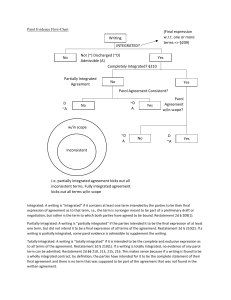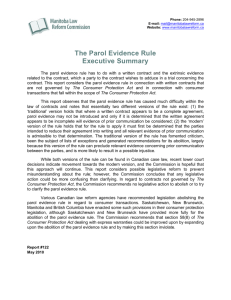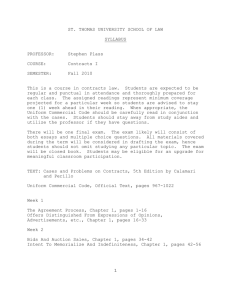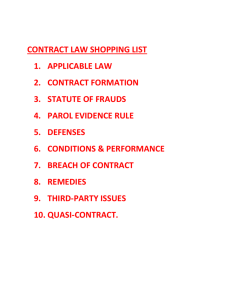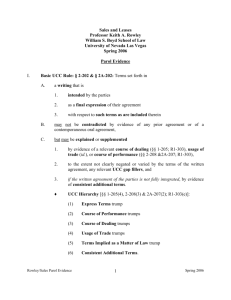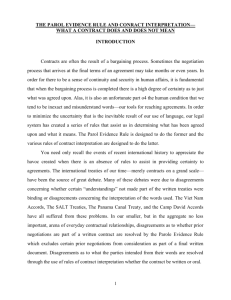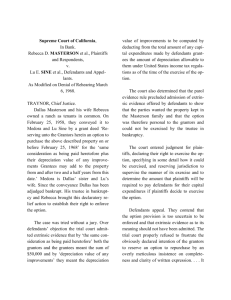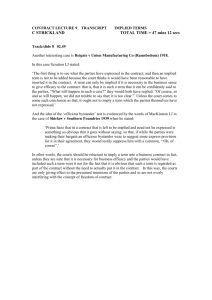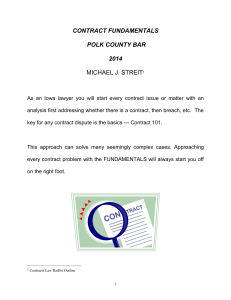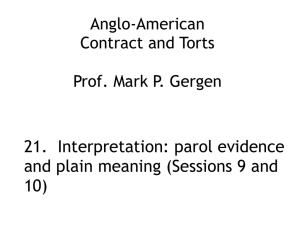contract law 3
advertisement
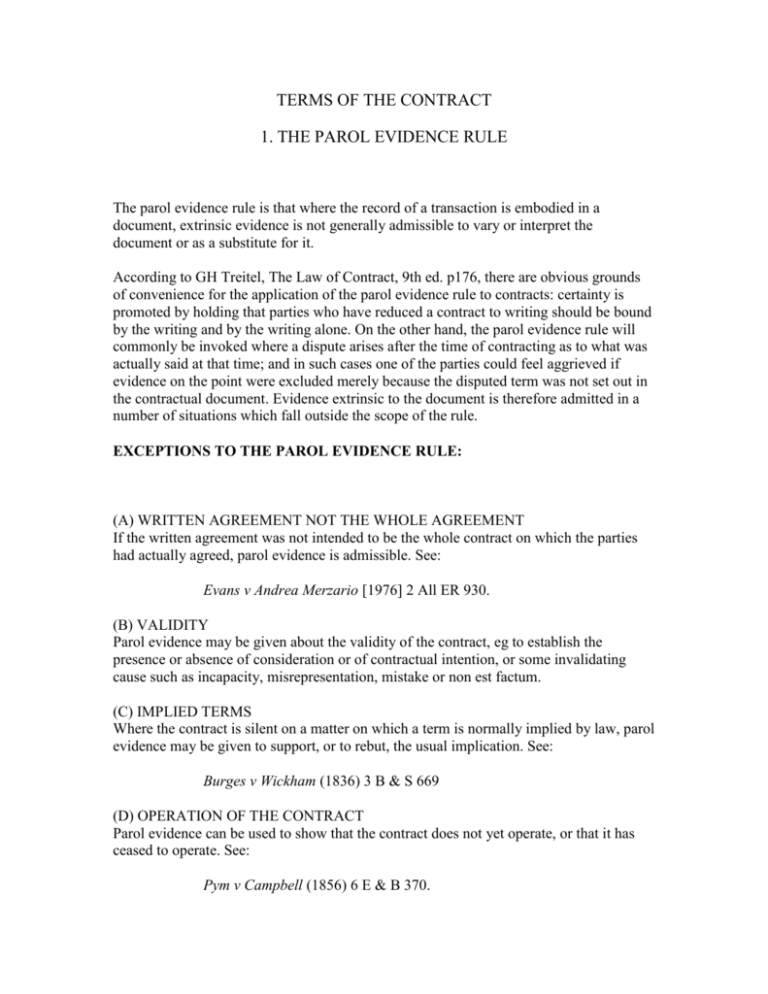
TERMS OF THE CONTRACT 1. THE PAROL EVIDENCE RULE The parol evidence rule is that where the record of a transaction is embodied in a document, extrinsic evidence is not generally admissible to vary or interpret the document or as a substitute for it. According to GH Treitel, The Law of Contract, 9th ed. p176, there are obvious grounds of convenience for the application of the parol evidence rule to contracts: certainty is promoted by holding that parties who have reduced a contract to writing should be bound by the writing and by the writing alone. On the other hand, the parol evidence rule will commonly be invoked where a dispute arises after the time of contracting as to what was actually said at that time; and in such cases one of the parties could feel aggrieved if evidence on the point were excluded merely because the disputed term was not set out in the contractual document. Evidence extrinsic to the document is therefore admitted in a number of situations which fall outside the scope of the rule. EXCEPTIONS TO THE PAROL EVIDENCE RULE: (A) WRITTEN AGREEMENT NOT THE WHOLE AGREEMENT If the written agreement was not intended to be the whole contract on which the parties had actually agreed, parol evidence is admissible. See: Evans v Andrea Merzario [1976] 2 All ER 930. (B) VALIDITY Parol evidence may be given about the validity of the contract, eg to establish the presence or absence of consideration or of contractual intention, or some invalidating cause such as incapacity, misrepresentation, mistake or non est factum. (C) IMPLIED TERMS Where the contract is silent on a matter on which a term is normally implied by law, parol evidence may be given to support, or to rebut, the usual implication. See: Burges v Wickham (1836) 3 B & S 669 (D) OPERATION OF THE CONTRACT Parol evidence can be used to show that the contract does not yet operate, or that it has ceased to operate. See: Pym v Campbell (1856) 6 E & B 370. (E) EVIDENCE AS TO PARTIES Parol evidence can be used to show in what capacities the parties contracted, eg where a person contracts ostensibly as principal, evidence is admissible to prove that he really acted as another's agent so as to entitle the latter to sue (Humfrey v Dale (1857) 7 E & B 266). (F) AID TO CONSTRUCTION Where the words of the contract are clear, parol evidence cannot be used to explain their meaning, unless they have a special meaning by custom. Parol evidence can, on the other hand, be used to explain words or phrases which are ambiguous, or which, if taken literally, make no sense, as well as technical terms. (G) TO PROVE CUSTOM Evidence of custom is admissible "to annex incidents to written contracts in matters with respect to which they are silent." (Hutton v Warren (1836). Custom can also be used as an aid to construction, eg in Smith v Wilson (1832) evidence was admitted of a local custom to show that "1,000 rabbits" meant "1,200 rabbits." (H) RECTIFICATION A document may fail in accurately recording the true agreement. Equity allows such a written contract to be rectified by parol evidence. (See handout on Mistake) (I) COLLATERAL CONTRACT Even though parol evidence cannot be used to vary or add to the terms of a written contract, it may be possible to show that the parties made two related contracts, one written and the other oral, ie a collateral contract. See: City & Westminster Properties v Mudd [1959] Ch 129. The Law Commission (1976) recommended that the rule should be abolished, but by 1986 concluded that it did not stop the courts accepting parol evidence if this was consistent with the intention of the parties. 2a. REPRESENTATIONS AND TERMS The first step in determining the terms of a contract is to establish what the parties said or wrote. Statements made during the course of negotiations may traditionally be classed as representations or terms and if one turns out to be wrong, the plaintiff's remedy will depend on how the statement is classified: · A representation is a statement of fact made by one party which induces the other to enter into the contract. If it turns out to be incorrect the innocent party may sue for misrepresentation. · Breach of a term of the contract entitles the injured party to claim damages and, if he has been deprived substantially what he bargained for, he will also be able to repudiate the contract. · If a statement is not a term of the principal contract, it is possible that it may be enforced as a collateral contract (which has developed rapidly in the twentieth century as a significant means by which the difficulties of fixing a statement with contractual force may be circumvented). How can the courts decide whether a statement is a term or a mere representation? It was established in Heilbut, Symons & Co v Buckleton [1913] AC 30, that intention is the overall guide as to whether a statement is a term of the contract. In seeking to implement the parties' intentions and decide whether a statement is a term or a mere representation, the courts will consider the following four factors: (A) TIMING The court will consider the lapse of time between the making of the statement and the contract's conclusion: if the interval is short the statement is more likely to be a term. See: Routledge v McKay [1954] 1 WLR 615 Schawel v Reade [1913] 2 IR 64. (B) IMPORTANCE OF THE STATEMENT The court will consider the importance of the truth of the statement as a pivotal factor in finalising the contract. The statement may be of such importance that if it had not been made the injured party would not have entered into the contract at all. See: Bannerman v White (1861) CB(NS) 844 Couchman v Hill [1947] 1 All ER 103. (C) REDUCTION OF TERMS TO WRITING The court will consider whether the statement was omitted in a later, formal contract in writing. If the written contract does not incorporate the statement, this would suggest that the parties did not intend the statement to be a contractual term. See: Routledge v McKay [1954] 1 WLR 615 Birch v Paramount Estates (1956) 167. (D) SPECIAL KNOWLEDGE/SKILLS The court will consider whether the maker of the statement had specialist knowledge or was in a better position than the other party to verify the statement's accuracy. See: Harling v Eddy [1951] 2 KB 739 Oscar Chess v Williams [1957] 1 All ER 325 Dick Bentley Productions v Harold Smith Motors [1965] 2 All ER 65. 2b. CONDITIONS AND WARRANTIES Traditionally terms have been divided into two categories: conditions and warranties. (A) CONDITIONS A condition is a major term which is vital to the main purpose of the contract. A breach of condition will entitle the injured party to repudiate the contract and claim damages. The injured party may also choose to go on with the contract, despite the breach, and recover damages instead. See: Poussard v Spiers (1876) 1 QBD 410. (Note: The word 'condition' also has another meaning. It may mean a stipulation that a contract should not be enforceable except on the happening of a given event, or should be brought to an end on the happening of a given event. The condition is then properly called a 'condition precedent', or a 'condition subsequent' respectively. See Cheshire & Fifoot, p153-4). (B) WARRANTIES A warranty is a less important term: it does not go to the root of the contract. A breach of warranty will only give the injured party the right to claim damages; he cannot repudiate the contract. See: Bettini v Gye (1876) 1 QBD 183. (C) INTERMEDIATE TERMS It may be impossible to classify a term neatly in advance as either a condition or a warranty. Some undertakings may occupy an intermediate position, in that the term can be assessed only in the light of the consequences of a breach. If a breach of the term results in severe loss and damage, the injured party will be entitled to repudiate the contract; where the breach involves minor loss, the injured party's remedies will be restricted to damages. These intermediate terms have also become known as innominate terms. See: Hong Kong Fir Shipping Co v Kawasaki Kisen Kaisha [1962] 1 All ER 474 The Mihalis Angelos [1971] 1 QB 164 The Hansa Nord [1976] QB 44 Reardon Smith Line v Hansen-Tangen [1976] 3 All ER 570 Bunge Corporation v Tradax Export [1981] 2 All ER 513. (D) NOTE If the term is described in the contract as a 'condition' that will not be conclusive. See: Schuler v Wickman Machine Tools [1974] AC 235. 3. IMPLIED TERMS In most contracts the primary obligations of the parties are contained in express terms. In addition there are various circumstances in which extra terms may be implied into the agreement. A) TERMS IMPLIED BY CUSTOM The terms of a contract may have been negotiated against the background of the customs of a particular locality or trade. The parties automatically assume that their contract will be subject to such customs and so do not deal specifically with the matter in their contract. See: Hutton v Warren (1836) 1 M&W 466. B) TERMS IMPLIED BY THE COURT (i) Intention of the Parties/Terms Implied as Fact The courts will be prepared to imply a term into a contract in order to give effect to the obvious intentions of the parties. Sometimes the point at issue has been overlooked or the parties have failed to express their intention clearly. In these circumstances, the court will supply a term in the interests of 'business efficacy' so that the contract makes commercial sense. See: The Moorcock (1889) 14 PD 64. A more recent test is the 'officious bystander test' used to incorporate implied obvious terms (Shirlaw v Southern Foundries [1940] AC 701). If while the parties were making their contract, an officious bystander were to suggest some express provision, they would both reply, "oh, of course." See, eg: Wilson v Best Travel [1993] 1 All ER 353. (ii) Relationship Between the Parties/Terms Implied by Law In certain relationships and contracts the law seeks to impose a model or standardised set of terms as a form of regulation. Such terms arising from the relationship between the parties will be implied as of law. See: Liverpool City Council v Irwin [1976] 2 All ER 39. C) TERMS IMPLIED BY STATUTE See the next Handout for the terms implied under: · Sections 12, 13, 14 and 15 of the Sale of Goods Act 1979; · Sections 13, 14 and 15 of the Supply of Goods and Services Act 1982; and · the relevant provisions of the Sale and Supply of Goods Act 1994.
